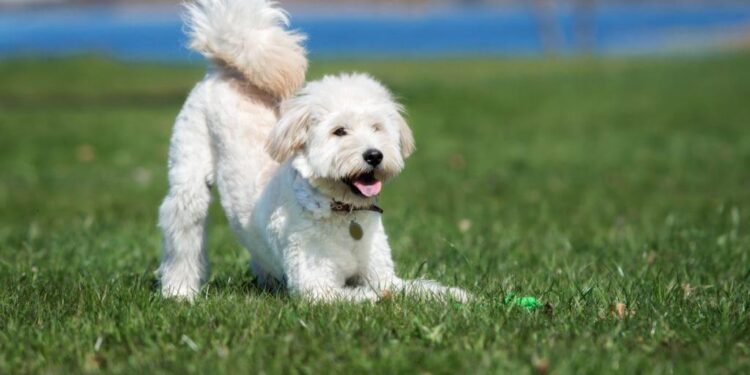Table of Contents
The Agony of Miscommunication
Introduction: The Day My Dog and I Stopped Speaking the Same Language
The walk started like any other, with a familiar knot of dread in my stomach.
My dog, a beautiful, intelligent golden retriever named Cooper, was a perfect angel indoors.1
He knew “sit,” “stay,” and a dozen other cues.
But the moment the front door clicked shut behind us, he became a different animal.
Our walks were a nightmare of pulling, whining, and lunging at anything that moved—a squirrel, a bicycle, another dog.1
I’d armed myself with all the “standard advice.” I’d watched countless YouTube tutorials from celebrated trainers, read forum posts, and tried every trick in the book: stopping dead when he pulled, abruptly changing direction, luring him with high-value treats like cheddar cheese that he’d promptly ignore the second a distraction appeared.1
That particular afternoon, we saw another dog approaching.
I braced myself, shortening the leash.
Cooper went rigid, his focus absolute.
The whining started, a low, frustrated hum that quickly escalated.
As the other dog passed, Cooper exploded into a frenzy of lunging and barking.2
I was mortified, wrestling with 70 pounds of pure frustration at the end of the leash.
The other owner gave me a look I knew all too well—a mixture of pity and judgment.
In that moment, I felt a profound sense of failure.
I loved this dog more than anything, but we were not connecting.
It felt like we were shouting at each other across a vast canyon, unable to understand a single word.
We weren’t a team; we were adversaries locked in a daily struggle, and it was breaking my heart.1
Why “Good Dog!” Isn’t Good Enough: The Unseen Flaws in Common Training Advice
My experience with Cooper wasn’t unique.
It’s a story that plays out in countless homes where loving owners find themselves at a breaking point.1
The core of the problem lies in a fundamental misunderstanding of how dogs learn and communicate.
We, as humans, are highly verbal creatures, but our pets are not.
To them, our constant stream of language is mostly background noise, making it incredibly difficult to pick out a single word and understand its precise intent.4
This leads to several critical flaws in common training approaches:
- The Problem of Vague Praise: When I said “Good dog!” to Cooper, what was I actually rewarding? The timing was almost always off. By the time the words left my mouth, he might have already stopped the desired behavior (like a brief moment of a loose leash) and started sniffing the ground or looking at a bird.5 The praise was too late and too general to be meaningful. The dog has no way of knowing which of the half-dozen actions they performed in the last five seconds was the “good” one.6
- The “Mishmash” Method Failure: In my desperation, I was guilty of what many owners do: cobbling together a training plan from dozens of conflicting sources.7 One day I was trying the “be a tree” method, the next I was luring with treats, and the day after I was attempting a specific leash-pressure technique I saw online.1 This is like trying to teach a child to tie their shoes by showing them the bunny-ears method, the loop-swoop-and-pull method, and a third technique all at once. The result is not a tied shoe, but a knotted mess of confusion for both teacher and student.7
- The Emotional Toll: This communication breakdown creates a destructive feedback loop. A dog’s frustration at not understanding what is expected can manifest in unwanted behaviors like incessant barking, destructive chewing, or even redirected aggression.7 The owner, in turn, feels helpless and frustrated, which taints their interactions with the dog. Their voice becomes strained, their body language tense. The dog picks up on this emotional noise, which adds another layer of stress and confusion, making learning even more difficult.6 This downward spiral erodes the trust and joy that should define the human-animal bond, leaving both parties feeling isolated and misunderstood.1 The issue isn’t a “bad dog,” but a broken system of communication.
The Epiphany of Precision
The Surgeon’s Scalpel: A New Way to See Communication
My turning point didn’t come from another dog training book.
It came from the world of human medicine.
I stumbled upon the story of Dr. Allan Levy, an orthopedic surgeon who, frustrated with the slow pace of training his residents, adopted a radical new tool: a clicker.6
He realized that to master a complex surgical technique, students needed to know the
exact instant their hand was in the correct position or they applied the right amount of pressure.
Verbal feedback was too slow, too subjective, and often loaded with emotion.
The clicker, however, was different.
It provided “nonjudgmental, instantaneous feedback”.6
It was a clean, precise signal that functioned like a mirror, telling the student, “YES.
That exact moment.
That’s what you need to repeat”.6
This analogy hit me like a lightning bolt.
I had been trying to perform delicate brain surgery on my training problems with a “melon baller”—my clumsy, emotionally charged verbal praise.9
The clicker was a surgeon’s scalpel.
It was a tool of pure precision, capable of isolating a single, fleeting moment of correct behavior—the split second Cooper’s leash went slack, the instant he glanced back at me instead of lunging—and marking it with perfect clarity.
It could cut through the noise of my own frustration and timing errors, delivering a message my dog could finally understand.6
The problem wasn’t Cooper’s inability to learn; it was my inability to communicate with precision.
Decoding the Science: How a Simple “Click” Rewires Your Dog’s Brain
The surgeon’s analogy opened the door to understanding the profound science behind this simple plastic box.
The effectiveness of clicker training rests on two foundational principles of behavioral psychology: classical and operant conditioning.10
- Classical Conditioning (The “Promise”): This is the first step, often called “charging the clicker.” You may remember Ivan Pavlov and his dogs, who learned to associate the sound of a bell with the arrival of food, eventually salivating at the bell alone.6 Clicker training starts the same way. A neutral stimulus (the unique “click” sound) is consistently paired with a primary reinforcer (a high-value treat). After several repetitions of click-then-treat, the dog’s brain forges a new connection. The click is no longer just a sound; it becomes a “conditioned reinforcer”.10 It becomes the
promise of a treat. The click itself begins to elicit a pleasurable emotional response in the dog, making them actively want to hear it.4 - Operant Conditioning (The “Action”): Once the click is charged with positive meaning, the second phase begins. This is where the dog learns it can “operate on” its environment to make the click happen.10 When the dog voluntarily offers a behavior—say, it sits—and that action is immediately marked with a click and followed by a treat, the dog learns a powerful lesson: “My action of sitting caused the promise of a reward!”.10 This is positive reinforcement. The click acts like a camera, taking a “snapshot” of the exact behavior you want to encourage, bridging the gap between the action and the reward.4 This allows you to pinpoint a micro-second behavior, like a dog lifting its paw, with a precision that is impossible to achieve by just fumbling for a treat.14
This two-step process does more than just teach a behavior; it fundamentally changes the dog’s entire approach to learning.
Traditional, correction-based training often relies on teaching a dog what not to do to avoid an unpleasant consequence, which can create fear and anxiety.15
A dog trained this way may become passive or “shut down,” afraid to try new things for fear of being corrected.17
Clicker training flips this dynamic.
The worst thing that can happen if the dog guesses wrong Is…
nothing.
No click, no treat.
There is no penalty for trying.
This freedom from fear encourages the dog to become an active, enthusiastic problem-solver, willingly offering behaviors to see which one will earn a click.11
This process gives the dog a sense of control and agency over its outcomes, which is a massive confidence builder.6
The clicker, therefore, is not just a communication device; it’s a tool for psychological empowerment.
It transforms training from a chore into a joyful, bond-strengthening game.19
The Practical Toolkit
The Clicker’s Code: A Step-by-Step Guide to Flawless Communication
Adopting this new paradigm requires mastering the tool.
Here is a step-by-step guide to using the clicker to build a clear, two-way line of communication with your dog.
Step 1: Charging the Clicker – Loading the Promise
The first goal is to teach your dog that “click = treat.” In a quiet area with no distractions, have your clicker in one hand and about 15-20 small, high-value treats in the other (or in a treat pouch).21 Click the clicker once, and immediately give your dog a treat.
The timing of the treat delivery is not as critical as the click, but it should follow swiftly.23 Repeat this process—click, then treat—until you see your dog’s eyes light up and their ears perk up at the sound of the click.
They are now anticipating the treat, and the clicker is “charged”.13
Step 2: The Art of the Click – Mastering Your Timing
Timing is everything.
The click must mark the behavior as it is happening, not after it’s over.23 To practice your timing without confusing your dog, try the “tennis ball game.” Have a friend bounce a tennis ball, and your goal is to click the exact instant the ball hits the floor.
This simple exercise hones the reflexes needed for precise marking.25
Step 3: Getting Behavior – Capturing, Shaping, and Luring
There are three primary ways to elicit a behavior you can click:
- Capturing: This is the simplest method. You wait for your dog to offer a behavior on their own and “capture” it with a click. If your dog lies down, click the moment their belly touches the floor.13
- Shaping: This is for teaching more complex behaviors. You reward successive approximations, or small steps, toward the final goal. To teach “go to your mat,” you might first click for the dog looking at the mat, then for taking a step toward it, then for putting one paw on it, and so on, gradually raising the criteria until they are lying down on the mat fully.15
- Luring: You can use a treat to guide your dog into a position. To teach “sit,” you might hold a treat over your dog’s head and move it slightly backward, causing their rear to lower. The instant their bottom hits the floor, you click and give them the treat.27
Step 4: Adding the Cue – Giving the Behavior a Name
This is a critical difference from many traditional methods.
The verbal cue (like the word “Sit”) is added only after the dog is reliably and voluntarily offering the behavior to earn a click.4 Once the dog is sitting consistently, you start saying “Sit” just as they begin the action.
Then, you begin clicking only the sits that happen after you’ve given the cue.
The dog quickly learns the word is the signal to perform the now-familiar action for a reward.4
Step 5: Fading the Clicker
A common misconception is that you’ll be tethered to a clicker for the rest of your dog’s life.
This is false.
The clicker is a tool for teaching new behaviors with precision.22 Once a behavior is learned and is reliable on its verbal cue, you no longer need to click it every time.
You can move to intermittent reinforcement (like a slot machine) and use praise, toys, or life rewards to maintain the behavior.24
Choosing Your “Scalpel”: An In-Depth Analysis of the Best Dog Clickers
Just as a surgeon chooses the right instrument for a specific procedure, a trainer should choose the right clicker for the dog, the handler, and the environment.31
There is no single “best” clicker, but understanding the options will help you find the perfect tool for building your new language.
At-a-Glance Clicker Comparison Guide
| Clicker Model | Type/Style | Sound Level | Ergonomics/Feel | Best For | Not Ideal For |
| Karen Pryor i-Click | Ergonomic Button | Soft/Quiet | Lightweight, easy to press, fits in palm | Sound-sensitive dogs, class settings, handlers with arthritis 31 | Long-distance outdoor training 32 |
| Classic Box Clicker | Box & Tongue | Loud & Crisp | Bulky, requires thumb pressure | Outdoor training, confident dogs, noisy environments 31 | Sound-sensitive dogs, handlers with limited mobility 32 |
| PetSafe Clik-R | Finger Loop | Soft/Muffled | Straps to finger, frees up hand | Multi-tasking, indoor training, new trainers 35 | Distance training, very loud environments 31 |
| COA Multi-Clicker | Adjustable Button | 3 Volume Levels | Bulky but versatile | Households with multiple dogs, progressing from quiet to loud 31 | Handlers who prefer a sleek, simple design 31 |
| Clik Stik | Target Stick Combo | Medium | Long wand | Advanced trick/agility training, targeting exercises 31 | Everyday walks, basic obedience 31 |
Detailed Reviews
- The Gold Standard for Most: The Ergonomic Button Clicker (Karen Pryor i-Click)
This is often considered the gold standard by professional trainers, and for good reason.36 The i-Click emits a softer, quieter click than traditional box clickers, making it ideal for dogs who are sensitive to loud noises or for use in training classes where multiple clickers are going off.31 Its ergonomic design fits comfortably in the palm, and the raised button requires very little pressure to activate, a significant benefit for handlers with arthritis or limited hand strength.31 Its small size also allows it to be hidden in your hand, preventing the clicker itself from becoming a visual cue that distracts the dog.38 - For the Great Outdoors & Confident Dogs: The Classic Box Clicker
The original box clicker’s main advantage is its sound. It produces a loud, crisp, distinct click that can cut through the noise of an outdoor environment, making it excellent for training at a distance.31 If your dog is confident and you do most of your training in parks or fields, this is a durable and reliable choice.34 However, its bulkier shape can be less comfortable to hold, and the metal tongue requires more deliberate pressure from a thumb, which can be difficult for some handlers.32 - For the Sensitive Soul: Soft-Sound & Adjustable-Volume Clickers
For a dog that is fearful or easily startled, the clicker’s sound is the most important factor. The PetSafe Clik-R features a muffled, soft plastic click and a convenient finger loop that keeps it attached to your hand without constant gripping, which is great for new trainers juggling a leash and treats.35 For ultimate versatility, the
COA Multi-Clicker has a patented volume control with three distinct levels.31 This allows you to start with a very soft click for a nervous dog and gradually increase the volume as their confidence grows, all without having to buy a new tool.34
Beyond the Clicker: The Power of the Verbal Marker and a Force-Free Philosophy
While the clicker is a phenomenal tool, it is not the only way to mark a behavior.
A sharp, consistent verbal marker—like the word “Yes!”—can be used in situations where a clicker is impractical, such as when your hands are full with a leash and grooming tools, or for dogs who are genuinely frightened by the clicking sound.39
This leads to a fascinating debate.
Some scientific studies have found no significant difference in the speed of learning between dogs trained with a clicker versus those trained with a verbal marker.20
This seems to contradict the overwhelming preference for clickers among many professional trainers.
The resolution to this puzzle lies not with the dog, but with the human.
The true genius of a physical clicker is that it forces the human to be a better, more consistent trainer.
A verbal “Yes!” can vary in tone, pitch, and volume depending on the handler’s mood—excitement, frustration, or fatigue can all color the word, creating inconsistency for the dog.14
A clicker makes the
exact same sound every single time, removing the handler’s emotional static from the equation.4
Furthermore, for most people, the physical reflex of a thumb pressing a button is faster and more precise than the cognitive process of forming and speaking a word.43
The clicker, therefore, is a mechanical aid for human precision.
It helps an imperfect human trainer deliver the perfectly timed, emotionally neutral signal that their dog needs to succeed.
Ultimately, the clicker is more than a tool; it’s an emblem of a training philosophy.
It aligns perfectly with force-free principles like LIMA (Least Intrusive, Minimally Aversive), focusing on building behavior through positive reinforcement, which fosters confidence and deepens the bond between person and P.T.19
From Frustration to Fluent Conversation
Conclusion: The Bond Rebuilt
A year after that disastrous walk, Cooper and I sat on the patio of a busy cafe.
I saw another dog walking toward us with its owner.
The old knot of dread was gone, replaced by a quiet confidence.
Cooper saw the dog, his ears twitched, and then he looked back at me, offering eye contact.
Click.
I tossed a small piece of chicken on the ground near him.
He ate it, glanced at the dog again as it passed, and then lay his head down on his paws.
He was calm.
He was confident.
He understood the game.
This transformation, mirrored in countless success stories from reactive dogs learning to cope to shelter dogs learning to trust, is the ultimate promise of clicker training.45
The journey began with the humbling realization that my dog wasn’t being “bad”; he simply didn’t understand what I was trying to say.
By trading my clumsy “melon baller” for a surgeon’s “scalpel,” I learned to speak his language.
The clicker gave us a bridge of clear, precise, and joyful communication.
It rebuilt our bond, transforming our relationship from one of conflict to one of collaboration.
The clicker is the tool, but the connection it forges is the true reward.47
Works cited
- At breaking point with my frustrated greeter. I have tried everything : r …, accessed August 13, 2025, https://www.reddit.com/r/Dogtraining/comments/1inf852/at_breaking_point_with_my_frustrated_greeter_i/
- Working with frustration/excitement barking – Positively | Victoria Stilwell | Forum, accessed August 13, 2025, https://forum.positively.com/viewtopic.php?t=14170
- Dog Training Fail – A Comedy of Errors – Something Wagging, accessed August 13, 2025, https://www.somethingwagging.com/dog-training-fail-a-comedy-of-errors/
- Why is Clicker Training Effective?, accessed August 13, 2025, http://clickertraining.com/why-is-clicker-training-effective/
- Clicker Training: Mark & Reward Dog Training Using Clickers – American Kennel Club, accessed August 13, 2025, https://www.akc.org/expert-advice/training/clicker-training-your-dog-mark-and-reward/
- Clicker Training for Humans: How Immediate Feedback Improves …, accessed August 13, 2025, https://cvm.msu.edu/vetschool-tails/clicker-training-for-humans-how-immediate-feedback-improves-learning
- The Missing Link: Why You’re Struggling to Train Your Pup and How a Comprehensive Dog Training Program Can Help – The Online Dog Trainer, accessed August 13, 2025, https://theonlinedogtrainer.com/comprehensive-dog-training-program/
- Frustration And Re-directed Aggression – Dog Problems Solved, accessed August 13, 2025, http://www.dogproblemssolved.com/frustration-and-re-directed-aggression/
- To Click or Not to Click, that is the Question | Susan Garrett’s Dog Training Blog, accessed August 13, 2025, https://susangarrettdogagility.com/2009/09/to-click-or-not-to-click-that-is-the-question/
- Deconstructing the Click | The Science Dog, accessed August 13, 2025, https://thesciencedog.com/2014/01/19/deconstructing-the-click/
- All About Clicker Training • Karen Pryor Clicker Training, accessed August 13, 2025, http://clickertraining.com/wp-content/uploads/2025/02/All-About-Clicker-Training-%E2%80%A2-Karen-Pryor-Clicker-Training.pdf
- The Science Behind Clicker Training – Faithfully Yours Dog Training, accessed August 13, 2025, https://fydogtraining.com/training-tips/2015/10/30/the-science-behind-clicker-training
- training dog and using clicker – Positively | Victoria Stilwell | Forum, accessed August 13, 2025, https://forum.positively.com/viewtopic.php?t=6261
- What’s the point of a clicker? : r/Dogtraining – Reddit, accessed August 13, 2025, https://www.reddit.com/r/Dogtraining/comments/bdhjp7/whats_the_point_of_a_clicker/
- Clicker training – Wikipedia, accessed August 13, 2025, https://en.wikipedia.org/wiki/Clicker_training
- Operant learning vs clicker training vs ”traditional” training – Retrieving for All Occasions, accessed August 13, 2025, https://www.retrievingforalloccasions.com/operant-learning-vs-clicker-training-vs-traditional-training/
- A Beginner’s Guide to Helping Your Reactive Dog Get Better, accessed August 13, 2025, https://www.3lostdogs.com/a-beginners-guide-to-helping-your-reactive-dog-get-better/
- The point in clicker training? – Positively | Victoria Stilwell | Forum, accessed August 13, 2025, https://forum.positively.com/viewtopic.php?t=4343
- Clicker Training Advise – Positively | Victoria Stilwell | Forum, accessed August 13, 2025, https://forum.positively.com/viewtopic.php?t=16210
- Why We Click | The Science Dog, accessed August 13, 2025, https://thesciencedog.com/2017/04/24/why-we-click/
- An Introduction to Clicker Mechanics – Karen Pryor Academy, accessed August 13, 2025, https://karenpryoracademy.com/an-introduction-to-clicker-mechanics/
- Clicker Training for Dogs, Step by Step – Your Pet and You, accessed August 13, 2025, https://yourpetandyou.elanco.com/us/behavior/guide-clicker-training-your-dog
- Fifteen Tips for Getting Started with the Clicker, accessed August 13, 2025, https://clickertraining.com/15tips/
- Clicker Training for Dogs 101 – Whole Dog Journal, accessed August 13, 2025, https://www.whole-dog-journal.com/training/clicker-training-101/
- How to Clicker Train Your Dog – An Intro to Positive Reinforcement Based Training, accessed August 13, 2025, https://www.youtube.com/watch?v=EVIzKL7RauQ
- How to Train Your Dog Using a Clicker | The Battersea Way – YouTube, accessed August 13, 2025, https://www.youtube.com/watch?v=3NydiXQQYiY
- bought my clicker – Positively | Victoria Stilwell | Forum, accessed August 13, 2025, https://forum.positively.com/viewtopic.php?t=72
- A Guide to Clicker Training Pets | Best Friends Animal Society, accessed August 13, 2025, https://bestfriends.org/pet-care-resources/guide-clicker-training-pets
- clickertraining.com, accessed August 13, 2025, http://clickertraining.com/why-is-clicker-training-effective/#:~:text=Clicker%20trainers%20differ%20from%20traditional,for%20it%20would%20be%20meaningless.
- Clicker training? Does it work or is it hype?, accessed August 13, 2025, https://forums.welltrainedmind.com/topic/311216-clicker-training-does-it-work-or-is-it-hype/
- 6 Best Dog Training Clickers [2025 Reviews & Ratings] – K9 of Mine, accessed August 13, 2025, https://www.k9ofmine.com/best-dog-training-clickers/
- Clickers Galore! Which One is Right for You? – The Laughing Dog, accessed August 13, 2025, https://www.northdakotadogtrainer.com/blog-1-1/blog-post-title-three-jk758
- i-Click Original Clicker, accessed August 13, 2025, https://shop.clickertraining.com/products/iclick-original-clicker
- Clicker Choices – Training Lines, accessed August 13, 2025, https://www.traininglines.co.uk/blog/clicker-choices/
- The 5 Best Dog Clickers for Effective Training – Rover.com, accessed August 13, 2025, https://www.rover.com/blog/the-6-best-dog-training-clickers-according-to-a-professional-dog-trainer/
- What’s a good training clicker? : r/Dogtraining – Reddit, accessed August 13, 2025, https://www.reddit.com/r/Dogtraining/comments/ctsl5q/whats_a_good_training_clicker/
- i-Click Clickers – Clean Run, accessed August 13, 2025, https://www.cleanrun.com/product/i_click_clickers/index.cfm
- I-click Clickers – Performance Dog, accessed August 13, 2025, https://performancedog.co.uk/shop/for-the-handler/clickers-and-targets-training-kit/i-click-clickers/
- Clickerless: How to Train Your Pet Without One | Fear Free Happy …, accessed August 13, 2025, https://www.fearfreehappyhomes.com/clickerless-how-to-train-your-pet-without-one/
- Train Your Dog Without a Clicker – Smart Dog University, accessed August 13, 2025, https://smartdoguniversity.com/train-dog-without-clicker/
- Does anybody on here have experience with clicker training? I’ve got a pretty reactive and rambunctious 11lb dog, any good resources on where to start? : r/reactivedogs – Reddit, accessed August 13, 2025, https://www.reddit.com/r/reactivedogs/comments/11bsvgj/does_anybody_on_here_have_experience_with_clicker/
- The click is not the trick: the efficacy of clickers and other reinforcement methods in training naïve dogs to perform new tasks, accessed August 13, 2025, https://pmc.ncbi.nlm.nih.gov/articles/PMC7906040/
- Anyone notice a difference in your dog when using a clicker vs. marker word, like ‘yes’ ? : r/Dogtraining – Reddit, accessed August 13, 2025, https://www.reddit.com/r/Dogtraining/comments/6656o8/anyone_notice_a_difference_in_your_dog_when_using/
- What is Clicker Training – Karen Pryor Academy, accessed August 13, 2025, https://karenpryoracademy.com/what-is-clicker-training/
- The Uncensored Story of How I Helped My Reactive Dog Get Better, accessed August 13, 2025, https://www.3lostdogs.com/the-uncensored-story-of-how-i-helped-my-reactive-dog-get-better/
- Case Studies | Behavioral Dog Training for Anxiety and Reactivity, accessed August 13, 2025, https://legendsdogtraining.com/case-studies/
- Dog Training Success Stories – Success Dogs, accessed August 13, 2025, https://www.successdogs.com/jeans-blog/dog-training-success-stories/






